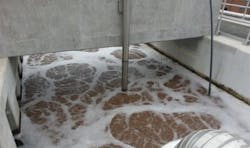Virginia’s Largest MBBR Protects the Chesapeake
As part of a long-term strategy to protect and restore the Chesapeake Bay, Fairfax County, Va., developed a nutrient reduction program (NRP) for the Norman M. Cole Jr. Pollution Control Plant (NCPCP) to significantly reduce nitrogen and phosphorus in the facility’s effluent. To meet Virginia’s Enhanced Nutrient Removal (ENR) regulations, the NCPCP needed to meet a total nitrogen (TN) effluent limit of 3.0 mg/L, which required effluent NOX-N (Nitrate-N + Nitrite-N) from the moving bed biofilm reactor (MBBR) to be less than 2.0 mg/L. At the same time, to meet biochemical oxygen demand (BOD) limits, the increase in sCBOD5 across the MBBR was required to be less than 1.0 mg/L.
The Solution
AnoxKaldnes MBBR technology utilizes engineered biofilm carriers to provide compact and efficient wastewater treatment. In municipal wastewater, MBBR is used for BOD removal, nitrification, deammonification and – in the case of the NCPCP – denitrification. The MBBR carriers support a robust population of biofilm to provide treatment; they are retained in the reactor with the use of stainless steel media retention screens. Top-entry or submersible mixers, depending on the application, perform mixing of anoxic reactors. Aeration of oxic zones is accomplished using stainless steel air grids.
Kruger designed a six-train AnoxKaldnes MBBR system to treat a future design flow of 78.4 mgd. There are five trains currently in operation, with the ability to add one additional train into service in the future. Each train consists of two anoxic MBBR reactors for denitrification. The anoxic reactors utilize AnoxKaldnes K1 media. Flat stainless steel screens retain the K1 carriers in the MBBR reactors. Submersible mixers provide mixing in the anoxic reactors. A methanol dosing system provides the carbon necessary for denitrification.
Following the anoxic MBBR reactors, each train is equipped with a re-aeration reactor to oxidize any excess methanol. The entire system is thus a precisely engineered balance to remove nitrogen to very low concentrations, while at the same time ensuring that excess carbon does not bleed through to the MBBR effluent. K1 media is used in the re-aeration reactors and retained with cylindrical stainless steel screens. AnoxKaldnes stainless steel medium bubble air grids provide aeration; they provide a robust, proven and maintenance-free mechanism for aerating MBBR reactors.
The Results
At the NCPCP, the AnoxKaldnes MBBR system proved itself during the 14-day performance test, when effluent NOX-N concentrations were maintained below the required 2.0 mg/L. The system has continued to provide consistent treatment, as shown by the six months of data covering the last half of 2015. The AnoxKaldnes MBBR system is allowing the NCPCP to meet Virginia’s strict ENR regulations to protect the region’s vital Chesapeake Bay resource.
